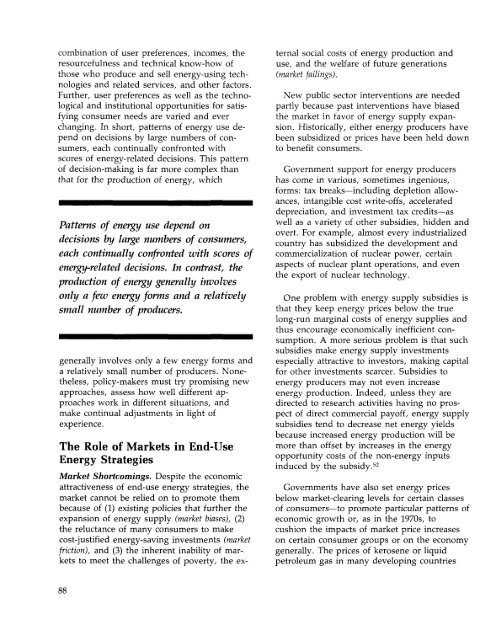ENERGY FOR A SUSTAINABLE WORLD - World Resources Institute
ENERGY FOR A SUSTAINABLE WORLD - World Resources Institute
ENERGY FOR A SUSTAINABLE WORLD - World Resources Institute
Create successful ePaper yourself
Turn your PDF publications into a flip-book with our unique Google optimized e-Paper software.
combination of user preferences, incomes, the<br />
resourcefulness and technical know-how of<br />
those who produce and sell energy-using technologies<br />
and related services, and other factors.<br />
Further, user preferences as well as the technological<br />
and institutional opportunities for satisfying<br />
consumer needs are varied and ever<br />
changing. In short, patterns of energy use depend<br />
on decisions by large numbers of consumers,<br />
each continually confronted with<br />
scores of energy-related decisions. This pattern<br />
of decision-making is far more complex than<br />
that for the production of energy, which<br />
Patterns of energy use depend on<br />
decisions by large numbers of consumers,<br />
each continually confronted with scores of<br />
energy-related decisions. In contrast, the<br />
production of energy generally involves<br />
only a few energy forms and a relatively<br />
small number of producers.<br />
generally involves only a few energy forms and<br />
a relatively small number of producers. Nonetheless,<br />
policy-makers must try promising new<br />
approaches, assess how well different approaches<br />
work in different situations, and<br />
make continual adjustments in light of<br />
experience.<br />
The Role of Markets in End-Use<br />
Energy Strategies<br />
Market Shortcomings. Despite the economic<br />
attractiveness of end-use energy strategies, the<br />
market cannot be relied on to promote them<br />
because of (1) existing policies that further the<br />
expansion of energy supply (market biases), (2)<br />
the reluctance of many consumers to make<br />
cost-justified energy-saving investments (market<br />
friction), and (3) the inherent inability of markets<br />
to meet the challenges of poverty, the external<br />
social costs of energy production and<br />
use, and the welfare of future generations<br />
(market failings).<br />
New public sector interventions are needed<br />
partly because past interventions have biased<br />
the market in favor of energy supply expansion.<br />
Historically, either energy producers have<br />
been subsidized or prices have been held down<br />
to benefit consumers.<br />
Government support for energy producers<br />
has come in various, sometimes ingenious,<br />
forms: tax breaks—including depletion allowances,<br />
intangible cost write-offs, accelerated<br />
depreciation, and investment tax credits—as<br />
well as a variety of other subsidies, hidden and<br />
overt. For example, almost every industrialized<br />
country has subsidized the development and<br />
commercialization of nuclear power, certain<br />
aspects of nuclear plant operations, and even<br />
the export of nuclear technology.<br />
One problem with energy supply subsidies is<br />
that they keep energy prices below the true<br />
long-run marginal costs of energy supplies and<br />
thus encourage economically inefficient consumption.<br />
A more serious problem is that such<br />
subsidies make energy supply investments<br />
especially attractive to investors, making capital<br />
for other investments scarcer. Subsidies to<br />
energy producers may not even increase<br />
energy production. Indeed, unless they are<br />
directed to research activities having no prospect<br />
of direct commercial payoff, energy supply<br />
subsidies tend to decrease net energy yields<br />
because increased energy production will be<br />
more than offset by increases in the energy<br />
opportunity costs of the non-energy inputs<br />
induced by the subsidy. 52<br />
Governments have also set energy prices<br />
below market-clearing levels for certain classes<br />
of consumers—to promote particular patterns of<br />
economic growth or, as in the 1970s, to<br />
cushion the impacts of market price increases<br />
on certain consumer groups or on the economy<br />
generally. The prices of kerosene or liquid<br />
petroleum gas in many developing countries

















